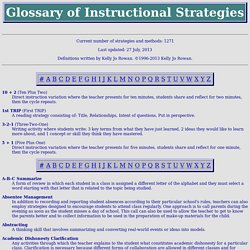

Marzanosnine.
Doing It Differently: Tips for Teaching Vocabulary. Every Monday my seventh grade English teacher would have us copy a list of 25 words she'd written on the board.

We'd then look up the dictionary definitions and copy those down. For homework, we'd re-write each word seven times. Good, now you know it. Test on Friday and never for those 25 words to be seen again. Poof. Copying definitions from the dictionary we would probably all agree is not an effective way to learn vocabulary. The truth is, and the research shows, students need multiple and various exposures to a word before they fully understand that word and can apply it. Selecting Words Ah, so many words, so little time. My first year teaching, before my tenth graders began reading Lord of the Flies, I went through every chapter and made lists of all the vocabulary words I thought they'd have trouble with, so that I could pre-teach them. When I looked at those long lists, I began to freak out. Then, here's what to do after the students pick their own words: Ranking Words Teaching Words.
Questions Before Answers: What Drives a Great Lesson? Recently, I was looking through my bookshelves and discovered an entire shelf of instruction books that came with software I had previously purchased.

Yes, there was a time when software was bought in stores, not downloaded. Upon closer examination of these instruction books, I noticed that many of them were for computers and software that I no longer use or even own. More importantly, most were still in shrink-wrap, never opened. I recalled that when I bought software, I just put the disk into the computer and never looked at the book. I realized that I did the same when I bought a new car -- with one exception. This pattern was and is true for every device I buy. The Need to Know Too many classrooms ignore this basic learning model. Lessons, units, and topics are more motivating when they begin with a question whose answer students want to know.
There is a catch, though, in using questions to begin your lesson. 10 Questions That Motivate Learning. Golden Rules for Engaging Students in Learning Activities. When we think of student engagement in learning activities, it is often convenient to understand engagement with an activity as being represented by good behavior (i.e. behavioral engagement), positive feelings (i.e. emotional engagement), and, above all, student thinking (i.e. cognitive engagement) (Fredricks, 2014).

This is because students may be behaviorally and/or emotionally invested in a given activity without actually exerting the necessary mental effort to understand and master the knowledge, craft, or skill that the activity promotes. In light of this, research suggests that considering the following interrelated elements when designing and implementing learning activities may help increase student engagement behaviorally, emotionally, and cognitively, thereby positively affecting student learning and achievement.
IS%20Kit%20excerpts. Alphabetized Listing of Instructional Methods. Glossary of Instructional Strategies. Current number of strategies and methods: 1271 Last updated: 27 July, 2013 Definitions written by Kelly Jo Rowan. ©1996-2013 Kelly Jo Rowan. 10 + 2 (Ten Plus Two) Direct instruction variation where the teacher presents for ten minutes, students share and reflect for two minutes, then the cycle repeats. 1st TRIP (First TRIP) A reading strategy consisting of: Title, Relationships, Intent of questions, Put in perspective. 3-2-1 (Three-Two-One) Writing activity where students write: 3 key terms from what they have just learned, 2 ideas they would like to learn more about, and 1 concept or skill they think they have mastered. 5 + 1 (Five Plus One) Direct instruction variation where the teacher presents for five minutes, students share and reflect for one minute, then the cycle repeats.

A-B-C Summarize A form of review in which each student in a class is assigned a different letter of the alphabet and they must select a word starting with that letter that is related to the topic being studied. Acronyms. Instructional Strategies for Engaging Learners. Differentiated Instructional Strategies.